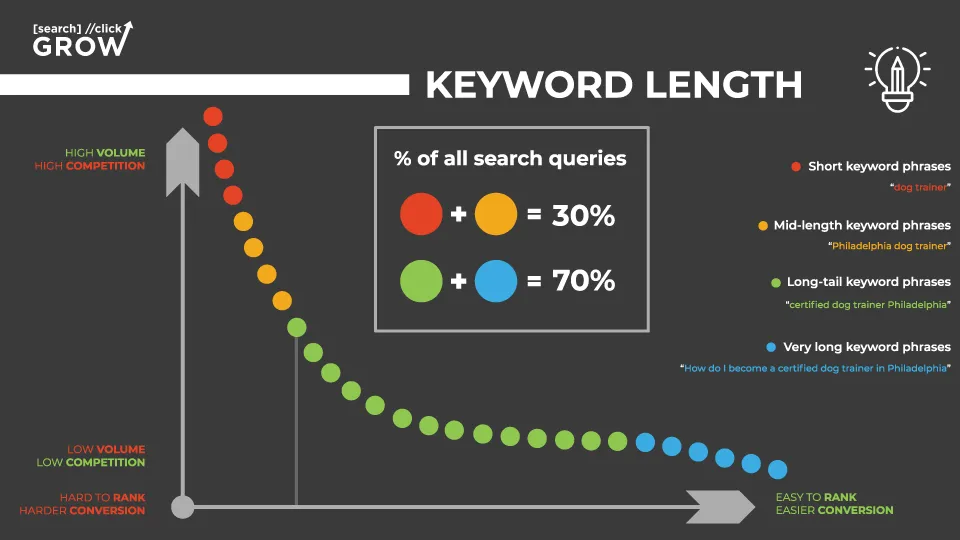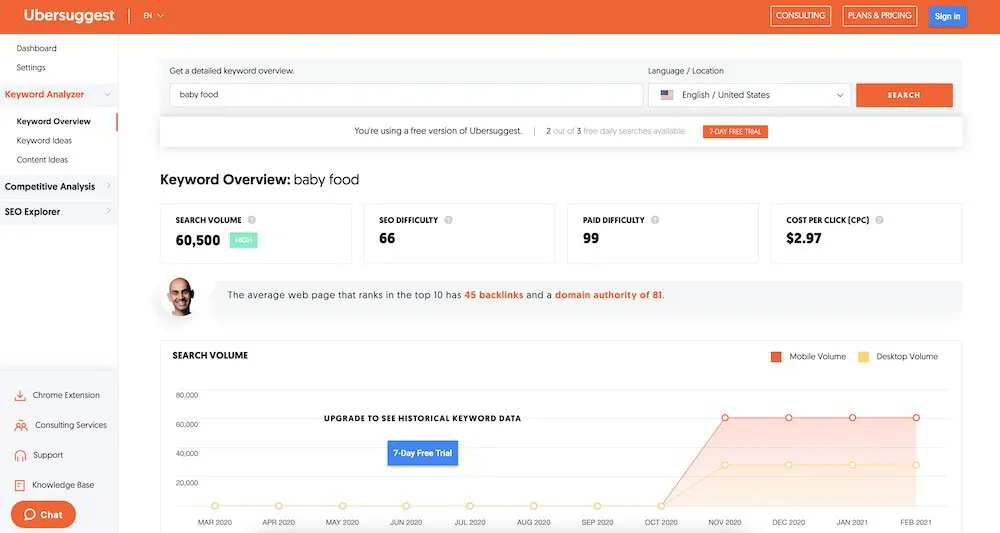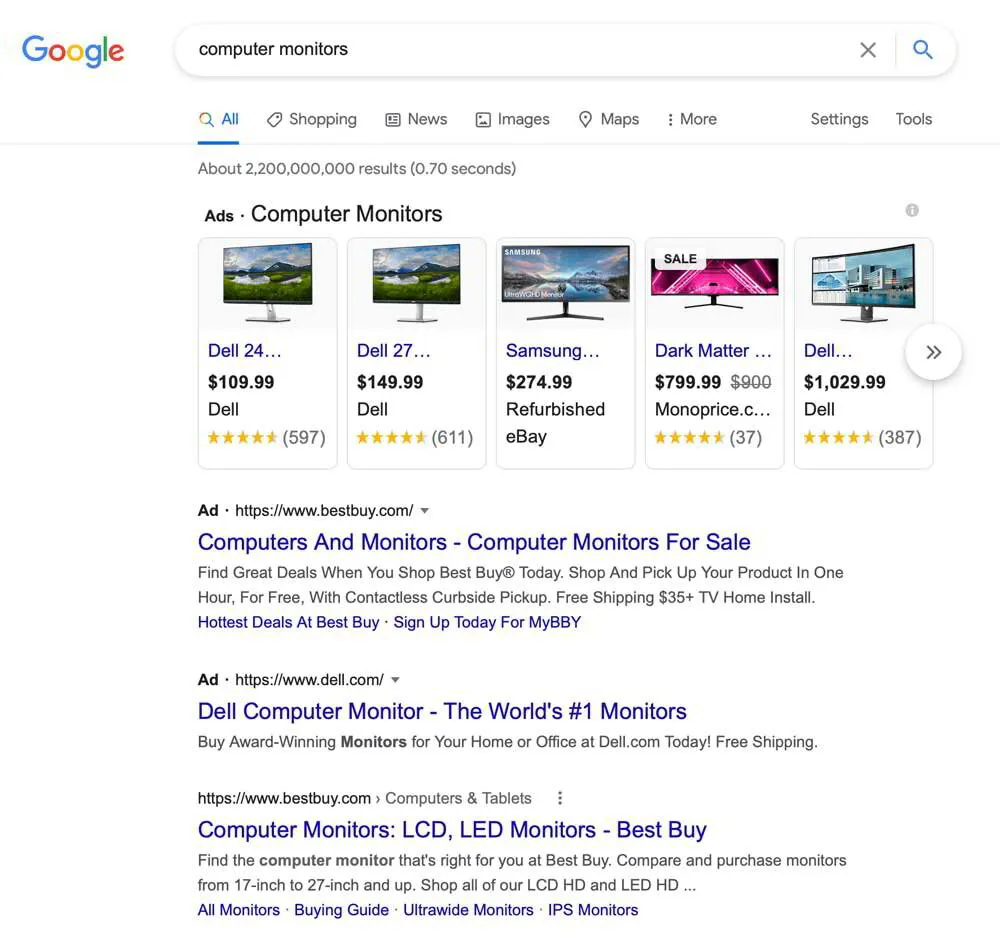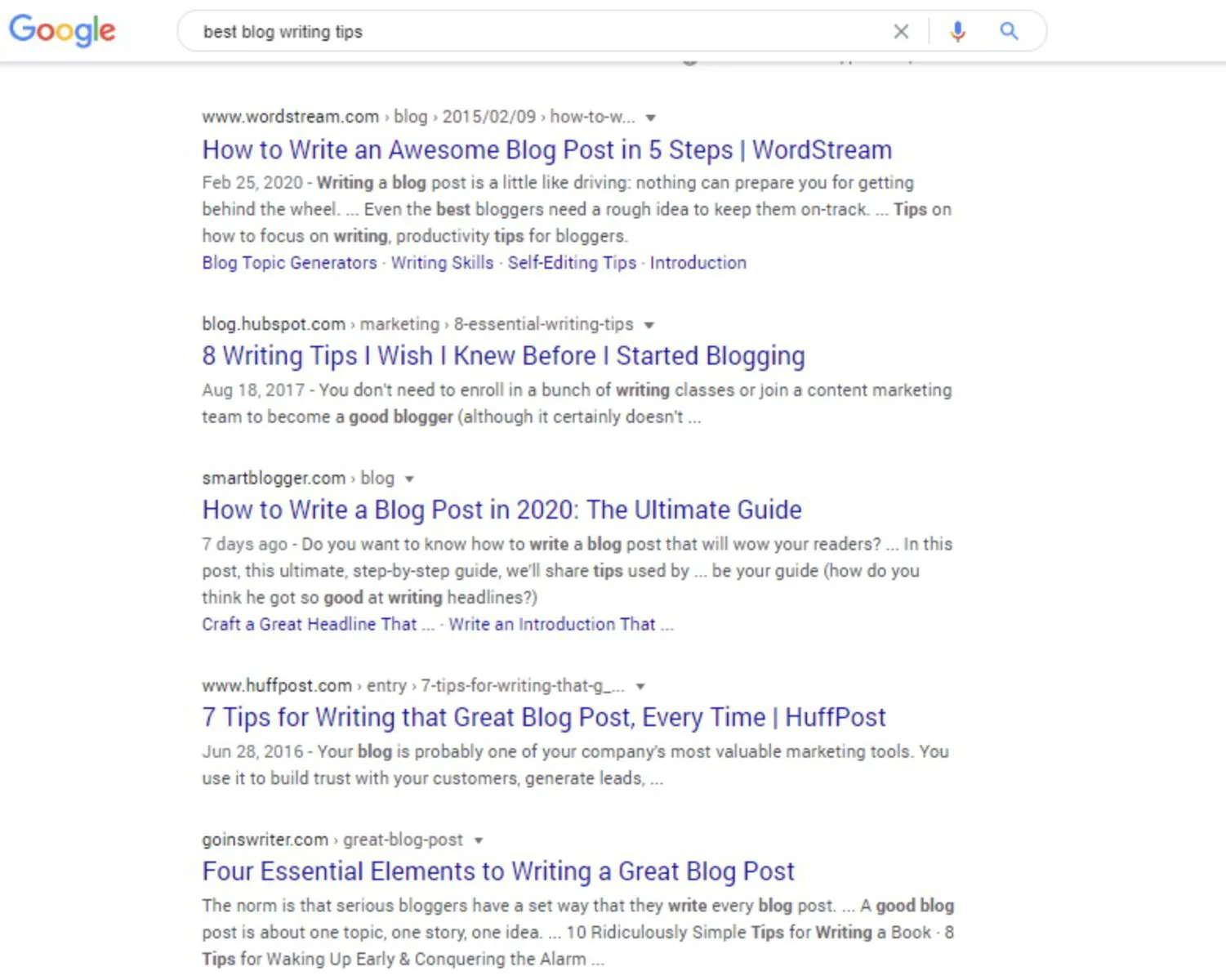05: How to Find Topics to Write About
Learn how to find the best topics to write about and craft must-read content to ensure you get engagement and clicks.
All Chapters List
Chapter 05 Overview
Do you want to write blog posts that entertain and convert? Most visitors are looking for information but barely ever get to the bottom of an article.
What if you could use those few precious seconds to hook readers with your content and convince them to take action? In this chapter, we’ll show you how to pick a topic and craft must-read content to ensure you get engagement and clicks.
Ideation and Topics to Write About
There are tons of resources out there to help you with blog topics. The best place to start is to think about your audience and what content would move them to read your blog.
Perhaps, you already know a few questions that you can answer for your audience. If you’re not sure what to write about, this section provides you with all the details and a 6-point checklist, so you can stop guessing and start writing something that your visitors will love to read.

Keyword Research & Ideas
Even if you don’t know what topics you want to write about, you probably at least know some basic keywords to get started. With the right tools to make life easier, you’ll have a list of topics in no time.
First, start off with a list of keywords that are highly relevant to your niche and products. Need help getting started? We’ve got a few tips to make this step go super fast.
What are the Best Keywords for Your Niche?
Here are a few tips to pick the right keywords and phrases for your topics:
- Think like your customers. What keywords or questions would they search to find information and products?
- Check the competition. What topics and keywords do you see? How can you expand and add more detail? Try the Keywords Everywhere Chrome extension and navigate to competitor websites or other blogs within your niche.
- Find long-tail keywords that play off of shorter keywords. Use AnswerthePublic.com to get some ideas.
- Choose keywords that have lower search volume. Try the KGR method for better results.
As you’re doing keyword research, keep in mind that you won’t always rank for higher search volume keywords, but you should still write topics related to these keywords by using modifiers.
For example, if you have a recipe blog, instead of writing about the “best pizza recipes,” you may want to try writing about the “best homemade pizza recipes” or “best gluten-free pizza recipes.”
In addition to these tips, there are some amazing keyword research tools and resources that can give you ideas in seconds.
- KeywordTool.io - Do you know what’s trending in your industry? You can use this free tool that lets you see what users are searching in your niche.
- Quora - This is a free resource where you can type in any keyword and get a bunch of questions and answers. What do you think your audience wants to know more about in your industry? You’ll find the answer here.
- SEMrush - While this isn’t a free tool, it’s worth the cost if you want the best keyword research, SEO tools, tracking, analytics, competitor research, and many other tools wrapped in one interface. We also love the SEO Writing Assistant from SEMrush, which grades and suggests keywords in real-time.
- Twitter Advanced Search - Here’s another free tool hiding within Twitter’s search. All you have to do is go to advanced search on Twitter.com, type in your keyword, and then select the “questions” filter from the dropdown. Now you can see all the questions that users are discussing within your industry.
- Keyword Explorer by Moz - This free tool requires you to create an account, but once you do, you can access all kinds of helpful information for keywords and SERP research.

Best Blog Topics to Write About
If you’re passionate about your niche, you’ll likely come up with a variety of topics to write about. However, you also want to consider what your audience is passionate about and how their interests tie into your blog.
In addition, some topics will be better than others for SEO, while others may purely be for a social media audience. Not everything has to have a high search volume
The tools above should give you a pretty good place to start, but here are some other topic ideas to help you brainstorm:
- How’d you get started in this business? Share how it all began by telling your story.
- List useful and helpful videos for your niche in a curated piece. For example, let’s say you run a fashion photography blog. You could put together 10 of the best videos you’ve found to help your readers learn more about the topic.
- Create the ultimate guide post, add the best products in your niche, and teach your readers about the tricks of the trade.
- List the most common questions related to your niche and answer them with your expertise.
- Answer the question “What doesn’t work in this niche?” or “What are some mistakes to avoid in your industry?”
- Curate a blog post with quotes or tips from the top celebrities in your niche.
- List all of the upcoming important dates or activities coming up within your niche. What are some important events or places that tie into your niche?
As you think about different topics, you also want to consider what topics will excite your reader and cause them to click on what you’re writing about.
6-Point Checklist for Blog Ideation
Once you have a list of topics, you should rank them in order of strength and potential to rank.
Here’s a 6-point checklist to determine which blogs will probably get the most traffic and engagement.

1. Long-Tail Keywords
One of the most important things you can do for your blog--and your business--is to use long-tail keywords. These are keywords or phrases that have four or more words.
The main goal with long-tail keywords is to be as specific as possible. For example, "how do I become a certified dog trainer in philadelphia" is more specific than "dog trainer".
Almost all of the top-ranking websites within your niche will likely be using the simplest keywords, which are highly competitive and hard to rank for as a new blog. However, you can still rank with long-tail keywords because of your audience intent and voice search.
Today's users are constantly asking longer questions through Siri, Alexa, or Google Home, and when they do, they'll find your content.

2. Keyword Volume
You want to rank for what's searched most, which is why it's important to combine long-tail keyword research with keyword volume. One word off in your long-tail phrase can drop your traffic to zero. So, you should look up the most searched keywords in your niche and use them in your content.
Ahrefs and Ubersuggest are two great tools to research keyword volume and see what people are searching for the most. Once you find these keywords, you can add keyword variations or questions that use these keywords with AnswerthePublic.com.
As long as you are changing up your keyword variations, you don't have to worry about using a popular keyword too many times in your content either.

3. Keyword DIfficulty
Another metric you'll see with keyword research tools is keyword difficulty. It may also be called SEO difficulty. This determines how difficult it will be to rank for a keyword or phrase on a scale from 1 to 100.
You shouldn't be deterred by keyword difficulty, but it will let you know what topics will need more optimization and content.
A more difficult keyword will likely require more research, and you'll need to outdo content already ranking for the same keyword.
For new sites, remember to keep your keyword difficulty scores less than 30. If you have built some traffic already, your keyword difficulty score can be as high as 60.
Again, you don't have to focus your entire blog around staying within a certain keyword difficulty, but you should keep it in mind as you research different topics and use tools like Ubersuggest or Ahrefs to see how difficult it will be to find your content.
4. Business Alignment
Whenever you look at a topic, first think about how it will align with your business and customer.
For example:
If you make a blog post about popular pizza recipes but your target audience is chefs, you've missed the mark. Chefs have their own recipes, but they may be interested in starting a restaurant or new kitchen tools such as the latest Japanese knives to enhance their craft.
Each of your blog topics should consider the direction of your business, your audience intent, and the challenges that your customers face. However, one of the best tips we can give is that nobody wants to read about things they already know.
In fact, it's a guaranteed bounce if your audience loads your page and reads what they already know. So ask yourself before you choose topics, does my audience already know about this? If so, how can you teach something new or create a topic that addresses the keyword in a new way?
5. Search Intent
We've mentioned it before, but it's important to pay attention to the keyword modifiers used by your audience. Fore example, there's a difference between pizza near me and pizza recipes or even water filters and water filter reviews. Google knows that if someone is searching for "recipes" or "reviews," then the SERP must show results that relate to these modifiers.
In fact, if you search a keyword and a bunch of shop links pop up and there are no blog results, then you should probably avoid this keyword. It's not going to help you rank.
The best way to review search intent is to type in part of a phrase and see what Google suggests to you. Once you load the SERP, analyze the top results and make a page that includes this information--but expands upon it in a way, adding more value.
In fact, if you search a keyword and a bunch of shop links pop up and there are no blog results, then you should probably avoid this keyword. It's not going to help you rank. The best way to review search intent is to type in part of a phrase and see what Google suggests to you. Once you load the SERP, analyze the top results and make a page that includes this information--but expands upon it in a way, adding more value.
It's important to offer information that no other result offers to your audience.

6. Evergreen Topics & Content
Finally, when writing content and planning for your blog, you may be tempted to look at news articles and trending topics. In the beginning, this content may work great for traffic, but what happens when the news story goes away? Your traffic will, too.
That's why your topics should focus on being evergreen. This means that your content doesn't have an expiration date, and it will work for today's visitor as well as a visitor a couple of years from now. One thing to remember is that you can always go back and update your old content. In fact, it's recommended that you do so, but the very first rule is to create content that's going to stand the test of time.

SERPs Research
Some topics will be harder to rank for than others. The goal is to include popular topics while not copying the top results already in Google.
Instead, you’ll add more details to create a better article than those already showing in SERPs for your keyword, topic, or headline.
Before you get started, now is the time to pull up that Google Sheets and enter your topics into separate rows on your spreadsheet. For each topic, you can add columns for your research such as “top related results” and “content length.”
To start, let’s do a quick search of your best topic in Google and click on the first five results.

- Click on each result and take note of the tone, style, and content length.
- Write down keywords and questions that you find in each result.
- Take note of the headline.
- Check the featured snippet for the SERPs to see what Google found to be the best answer for the query.
- What’s the meta description? What captions and image alt text, anchor text, and sources does the blog use?
- Add anything missing from the content, such as images, diagrams, questions, keywords, and other elements that you can add in your content.
From your research, you should have a few notes on each topic to help you get started, including:
- Content length
- Keyword competition
- Style, formatting, and tone
- Images and videos (what can you add to yours that’s different)
- Questions and related topics unanswered by top results
- Featured snippet and what Google thinks is most relevant to the keyword
- What call-to-actions are used?
After you conduct your SERPs analysis, you’ll have a better idea of the competition and may even feel inspired to write something better.
If you find there is a lot of competition for a topic, you can always break it down into a related topic and go into more detail or go for it anyway. You may be able to provide more knowledge and expertise than what’s already in search.
Decide Content Types & Direction
In this section, we look at what types of content work best and why. There are millions of blogs out there with content that festers without ever drawing any traffic or readership. In most cases, these blogs were created without any goals.

What you write about should be driven by what you want to do with your blog. Of course, everyone wants to get traffic, but what do you want visitors to do once they’re on your blog Maybe you want more engagement and comments, or perhaps you have products to sell. There are also blogs looking for email subscribers.
The point is to determine the content type and direction, you need to have your goal in mind, then choose the kind of content that will match what you’re looking for. Ideally, your blog blends together a variety of content types so it doesn’t get too stale. Here are some of the popular types:
1. Lists
By far the most popular content type in blogging is the list type. These are the “15 Secrets to Saving Money” or “10 Ways to Improve Your UX” blogs that you constantly see when you search any topic or keyword. List posts are highly readable because they are easy to skim.
Lists are helpful because they help your users learn more about a problem and solve it with one or more of the items you present. While there are a ton of top 10 lists out there, you’ll need to be more creative with the number of items and how you write your headline.
You should always have a variety of list posts on your blog, but they need to be interesting and different than other lists relating to the same topic. Otherwise, you won’t ever beat a list already ranking pretty high.
To beat out another list post on the topic, you’ll need to change up the items on the list and add more items or take a creative spin on it while still answering the query and matching audience intent.
2. Case Studies or Success Stories
People are always interested in how other people approach an activity, problem, or question, which is why this type of post requires good storytelling. You typically want to use a three-act structure with this post:
- Act 1: Set the scene by talking about the challenge or problem. This should relate to something the audience is dealing with.
- Act 2: Here’s where you discuss the actions, skills, or experiences that helped solve the problem. What was the “Eureka!” moment that made it all work out?
- Act 3: What’s the result? Talk about the resolution and what’s next.
You should be able to talk about failures and successes within your niche, as it’s likely your audience will want to know about both.
Remember that your stories should always go back to your products or expertise aided in the journey.
3. Tutorials and How-to Guides
Other visitors simply are looking for how to do something or want to solve a problem with a step-by-step approach. It’s your blog’s time to shine.
- Solve a problem by identifying a challenge for your audience. Write an in-depth guide that’s easy to read and makes sense so that any visitor could figure out how to do it with your approach.
- Break up your tutorials with visual guides, checklists, quotes, and bullet points.
Longer guides tend to get more readership, but you still want to format your blog so that it’s easy to skim and consume.
4. Question and Answer
There’s nothing better than a potential customer typing in a query in Google and finding the question pop up in the first five results. If your blog is one of them, you likely just gained some traffic.
Question and answer posts should always answer the question within the second paragraph of the introduction, followed by a lead-in sentence to the body content. This is how you get a featured snippet in Google.
You can use tools like AnswerthePublic.com to find all of the related questions to a keyword and answer them all in one post or create multiple posts for different questions.
5. Reviews and Comparisons
If you are writing transactional content, the best thing you can do is write reviews for similar products and rank them, including comparisons and guide information.
There will likely be posts out there with reviews already, so you’ll need to focus on your SERPs research to ensure that you pick new and interesting products to review and compare.
6. Videos or Infographics
Everyone loves videos and infographics that provide great visual examples of a problem, question, or demonstration of a product to purchase.
- Focus on quality and optics. Your video or graphics should be visually appealing.
- Include fresh content, new research, and relevant studies when presenting statistics and sources.
- Make it shareable. Upload your video to YouTube or share your infographic on Twitter.
We know that this content will require more time, but having just one video can really improve your blog visibility.
7. Resources and Tools
Want to deliver the most value to your audience? Providing a list of tools or resources is a great way to add content to your blog while also drawing in an audience who wants to learn more about the topic.
We suggest providing a long list of resources and tools as your audience will typically consume all of the content. You should also provide a description, screenshots, pros and cons, and best case use for each resource or tool.
8. Personal Stories
Do you have an experience to share? It’s no secret that social media loves when people are human and share authentic emotions about important topics. There are many ways to share personal stories and stay on topic within your niche.
For example, you can write a personal essay that shares an experience from your life where something happened that changed you as a person. While you should steer clear of ranting, you can also share opinions and your own theories within your niche. Perhaps you want to write “what not to do when buying a car” or “how to invest in stocks when you’re not a stockbroker.” These are experiences that you can share and draw attention to what you learned.
When you share personal stories, remember that your intent is to inspire and not bait emotions. While it’s tempting to write something for the sake of hyping up a reader, it’s never a good idea to trick readers, who are more adept at spotting clickbait and spammy content.



